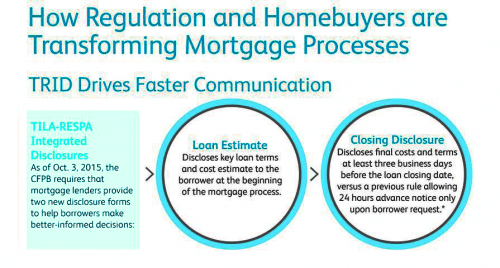In this article:
Some mortgage disclosure forms are more important than others. They are:
- The Loan Estimate form (LE)
- The Closing Disclosure (CD)
- Your mortgage Note or Deed
Most of the sea of paperwork you’ll encounter can be skimmed. Just remember that you’re responsible for everything in that final set of papers that you sign at closing.
Verify your new rateThe most important form: Loan Estimate (LE)
The Loan Estimate form gives you the most critical facts about your loan. The lender must issue one within three business days when you apply for a mortgage. However, many will give you one, if asked, when you shop for a home loan.
Reader question: How can I shop for home loans if lenders won't give me a Loan Estimate?
If you can get a Loan Estimate form, that’s better than just a “worksheet” or “scenario” because it provides certain consumer protections that worksheets do not. If you like an offer from a worksheet, though, and decide to apply for the loan, you will get a Loan Estimate form eventually.

What’s on the Loan Estimate?
Page 1 of the Loan Estimate form makes it pretty easy to compare offers from lenders. That’s because the loan amount, interest rate, monthly payment and closing costs all appear here.
4 ways to keep your mortgage closing costs low
It also tells you if your payment is fixed or adjustable, and how it could adjust if the loan is an ARM. Page 1 also discloses prepayment penalties if they exist. Perhaps most importantly, Page 1 estimates your total cash to close. So there should be no real surprises at the closing table.
The loan estimate, in the upper right hand corner of the first page, has a checkbox. This important section tells you if you have a locked interest rate. It indicates how long that lock applies.
Other cool stuff on the Loan Estimate
Before the introduction of this form in 2015, most mortgage applicants just worked with the lender’s chosen providers and paid the costs they were charged.
Today, depending on where you live, you may be able to shop yourself for some of those third-party services, reducing your borrowing costs. Page 2 of the Loan Estimate form indicates what these third party charges are, and if you’re allowed to shop around and choose your own provider.
Taking out the garbage: How to avoid junk fees and bogus closing costs
You’ll get a Written List of Providers for the third-party expenses. You don’t have to use the lender’s choice of providers unless the law says you do, and this differs among states. Not all let you shop for title insurance, but when you can, there may be a lot of savings on the table.
For example, you may be able to get a good discount on title insurance when refinancing if you use the same insurer you used before. The lender won’t know this.
You won’t get to pick your own appraiser, however. That’s to make sure that the appraisal is objective. In fact, your lender doesn’t even get to choose the appraiser, either.
Comparing lenders with the Loan Estimate

The third and final page lets you compare lenders head-to-head. It tells you the total costs of the loan and the mortgage APR, or annual percentage rate.
It even lets you compare costs during the first five years of your loan. That’s a useful feature, because most homeowners don’t keep their mortgages for a full 30 years.
How to shop for a lower mortgage rate
Two loans with the same APR could have very different costs. One might require a lot of money upfront to give you a lower interest rate and payment. Another loan might come with a higher payment, but fewer upfront costs. This five-year comparison is more realistic for many than a 30-year APR vs APR analysis.
The Closing Disclosure
At least three business days before you close on your home loan, you’ll get a Closing Disclosure, which you can compare to the most recent Loan Estimate you have (lenders have to send you updated ones if the loan’s terms change).
How to prepare for your real estate closing
For many of the charges, the actual costs have to match or be very close to the estimated costs. Check the Closing Disclosure against the Loan Estimate, line by line. If certain costs exceed the estimate, the lender has to eat the difference, not you.
Confusing mortgage disclosures you can pretty much ignore
Many trees could be saved if this stuff weren’t required to be printed and given to you. They do make good paper airplanes, however.
- Appraisal Report Disclosure: It says you have the right to a copy of your appraisal
- ARM Rider: If you have an ARM, this one just repeats what’s in the note and the Loan Estimate
- Attorney Selection Notice: If you want an attorney at closing, you can have one
- Authorization to Release Information: This doesn’t actually disclose anything, but it’s necessary. By signing, you grant permission to the lender to check your credit and verify employment
- Consumer Privacy Policy Notice: It tells you that your financial information is private, and who gets what information regarding your loan
- Equal Credit Opportunity Act Notice: It tells you that lenders are not allowed to discriminate against those in protected classes (race, age, etc., ) and where to complain if your lender picks on you unfairly
- Escrow Account Waiver: If you don’t want the lender / servicer to collect and pay property taxes and insurance premiums, you may have to sign this, agreeing that you’re responsible for those payments
- Fair Credit Reporting Act Notice: It says that your mortgage payment history, including default or delinquency, can be reported to credit bureaus
- IRS Forms W-9 and 4506-T: These grant permission to lenders to verify your income with the IRS. So don’t forge any W-2s and you’ll be fine.
- Name Affidavit: You indicate that you know who you are
- Servicing Disclosure: It tells you that your payments might be collected by a company other than your lender.
- Tangible Net Benefit Worksheet: In some states, the lender must prove that a refinance will leave you better off than you’d be without it. Because so many people want to refinance to a worse loan.....

Government loan disclosures
It wouldn’t be a government loan without some extra-special additional paperwork. But these forms are also no big deal.
Common government-backed loan disclosures include:
- FHA Informed Consumer Choice Disclosure Notice Tells you that you may also qualify for non-government loans, and recommends that you compare costs of both
- Important Notice to Home buyers Reminds you that the government backs your loan but does not guarantee the condition or worth of the property
- HUD/VA Addendum to Uniform Residential Loan Application Tells you that if the property does not appraise for at least the purchase price, you can bring in more cash to close the deal, but you’re not obligated to
- For Your Protection: Get a Home Inspection Again, the condition of the property is not guaranteed by any agency. You are advised to (but not required to) get a home inspection
- HUD Appraised Value Disclosure Confirms the property appraised value
- HUD Amendatory Clause This also says that you don’t have to complete the purchase if the property does not appraise for at least the sales price. But this is required by law to be added to your sales contract with the seller if you choose a government-backed mortgage.
Much of what you get from your lender can be filed or forgotten. Keep the Closing Disclosure and your Note or Deed (the final mortgage document). The rest can be filed, forgotten, or become part of an origami project.
What are today’s mortgage rates?
Today’s mortgage rates continue to move within a very narrow range, and they continue to be highly affordable. The mortgage rate is one of the most important terms you will see in that pile of paper. Use your Loan Estimate form to make shopping easier, and compare quotes from several lenders.
Time to make a move? Let us find the right mortgage for you
